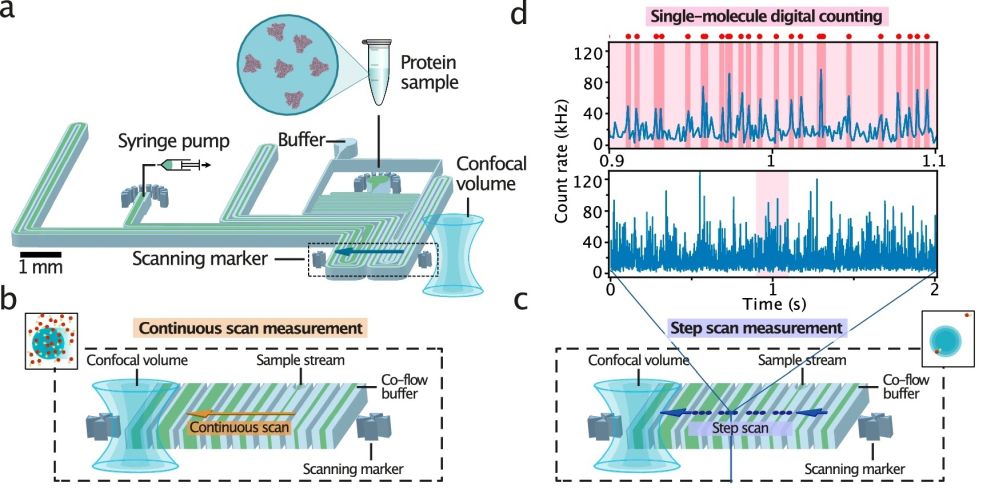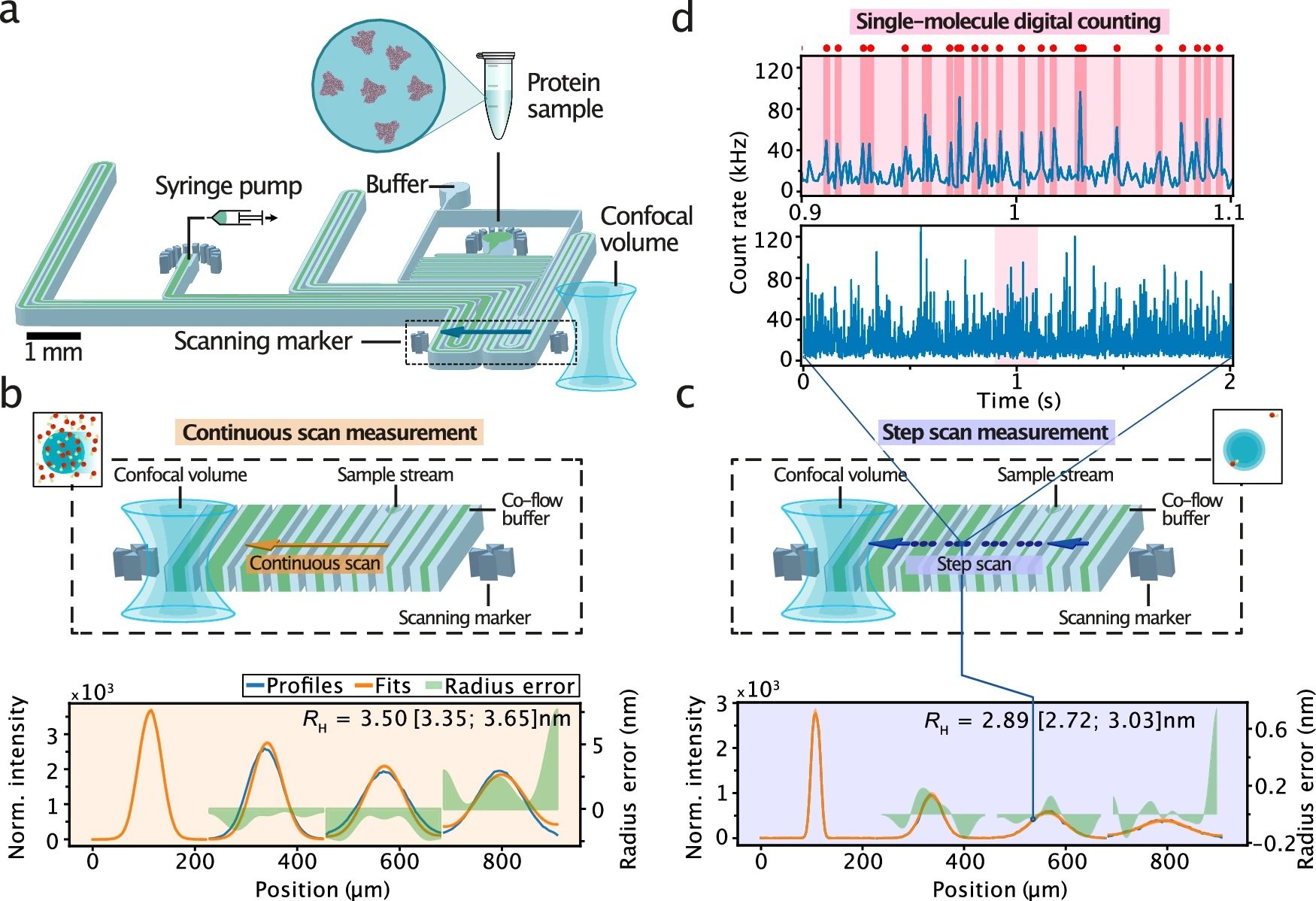
14 Sep Advancements in Protein Sizing with Single-Molecule Microfluidic Diffusional Sizing
Understanding of a protein’s true behavior in biological systems remains a cornerstone for understanding biological functions and addressing diseases. Traditional methods, while useful, often fall short when it comes to dealing with proteins in their natural, or native, states—particularly when these proteins are polydisperse or part of complex biological mixtures. This limitation can skew our understanding of proteins. Enter the innovative microfluidic approach developed by researchers: single-molecule microfluidic diffusional sizing (smMDS), which promises to tackle these challenges head-on.
“Here, we address this challenge by introducing single-molecule microfluidic diffusional sizing (smMDS). This approach measures the hydrodynamic radius of single proteins and protein assemblies in microchannels using single-molecule fluorescence detection. smMDS allows for ultrasensitive sizing of proteins down to femtomolar concentrations and enables affinity profiling of protein interactions at the single-molecule level. “, the authors explained.

“a Schematic of the microfluidic chip design and integrated confocal scanning optics. The most relevant components are depicted. The dashed box highlights the scan region. The arrow indicates the scan trajectory across the four innermost channels. b Principle of continuous scan measurements. The confocal detection volume is moved at a constant speed across the microfluidic device, enabling the recording of diffusion profiles from direct intensity readouts. This mode enables recording of diffusion profiles under ensemble conditions. An exemplary diffusion profile from a continuous scan measurement of human serum albumin (HSA) at 100 nM is shown. Diffusion profiles are shown as blue lines, experimental fits as orange lines, and the local radius errors as green bands. Extracted hydrodynamic radii RH [with errors] are given as an inset. The local radius error is calculated as the difference between the hydrodynamic radius derived from the global fit and that obtained from the best matching profile at that specific position. The error range for RH is derived from the global fit, determined through a Taylor expansion of the least-square fit and through error propagation (see Supplementary Note 1 for details). c Principle of step scan measurements. The confocal detection volume is moved in a stepwise manner across the device, collecting data at defined positions with each step for a certain period of time in the form of time traces (see panel d). This mode enables detection of individual molecules and the creation of diffusion profiles from single-molecule digital counting. An exemplary diffusion profile from a step scan measurement of α-synuclein at 10 pM is shown. d A single-molecule time trace (lower panel) as obtained from a step scan measurement is shown. The time trace in the upper panel is a zoom-in view of the red shaded area in the lower panel. Red dots and highlighting indicate bursts detected by the burst-search algorithm. The bin time is 1 ms in all traces.” Reproduced from Krainer, G., Jacquat, R.P.B., Schneider, M.M. et al. Single-molecule digital sizing of proteins in solution. Nat Commun 15, 7740 (2024). under a CC BY 4.0 Attribution 4.0 International license
- Protein Sizing: Hydrodynamic radii measurements were consistent with expected values from literature, confirming the accuracy of smMDS.
- Sensitivity: The method detected protein concentrations as low as 100 femtomolar.
- Interactions: It was also capable of profiling protein interactions by detecting changes in hydrodynamic radii upon complex formation.
At the heart of smMDS is a PDMS-based microfluidic device, microfabricated using standard soft-lithogrpahy techniques, that seamlessly integrates with confocal fluorescence microscopy. Proteins labeled with fluorescent markers are flowed through a microchannel, where their movement is illuminated and captured. The data collected is then analyzed to determine the diffusion profiles of the proteins, which reveal their sizes based on how they spread out over time and distance.
The effectiveness of smMDS was demonstrated across various protein types, including monomers and oligomers, in complex mixtures. Key findings include:
- Consistent Sizing: The measured hydrodynamic radii were consistent with known values from literature, underscoring the method’s accuracy.
- Detection Capabilities: It successfully detected protein interactions by observing changes in hydrodynamic radii upon protein complex formation.
- Broad Applicability: The method’s ability to analyze proteins at extremely low concentrations and without altering their state makes it a powerful tool for biomedical research and beyond.
The development of smMDS represents a significant step forward in protein analysis, providing researchers with a powerful tool to study proteins under near-native conditions. This technique not only enhances our understanding of protein dynamics but also opens new avenues for the development of therapeutic strategies targeting protein-related diseases. As we continue to push the boundaries of what’s possible in protein science, smMDS stands out as a beacon of innovation, enabling deeper insights and more effective interventions in health and disease.
“Given the key features of the technique, we anticipate that the smMDS approach will have a multitude of applications in quantifying the sizes and interactions of proteins and other biomolecules in various areas of biological and biomedical research, including the mechanistic and functional analysis of proteins, the molecular design of protein therapeutics, and the characterization of nanomedicines and biomaterials. “, the authors concluded.
Figures are reproduced from Krainer, G., Jacquat, R.P.B., Schneider, M.M. et al. Single-molecule digital sizing of proteins in solution. Nat Commun 15, 7740 (2024). https://doi.org/10.1038/s41467-024-50825-9 under a CC BY 4.0 Attribution 4.0 International license.
Read the original article: Single-molecule digital sizing of proteins in solution
For more insights into the world of microfluidics and its burgeoning applications in biomedical research, stay tuned to our blog and explore the limitless possibilities that this technology unfolds. If you need high quality microfluidics chip for your experiments, do not hesitate to contact us.


